Capturing dynamic footage involves more than just technical skills; it requires creativity and a keen eye for movement and composition. By exploring various techniques and approaches, you can produce visually engaging and memorable videos. This guide offers creative strategies for capturing dynamic footage that stands out.

Experiment with Camera Angles
Changing camera angles can dramatically alter the perspective and energy of your footage:
- Low Angles: Position the camera close to the ground to create a powerful, dramatic effect. This angle can make subjects appear larger and more imposing.
- High Angles: Shoot from above to offer a broader view and highlight context. High angles can make subjects appear smaller or more vulnerable.
- Dutch Angles: Tilt the camera to one side to create a sense of unease or tension. This angle adds a dynamic and unconventional look to your footage.
Exploring different angles adds variety and visual interest to your video.
Incorporate Dynamic Camera Movements
Camera movements can bring a sense of motion and excitement to your footage:
- Panning: Move the camera horizontally to follow a subject or reveal new elements. Panning adds a sense of motion and continuity.
- Tracking Shots: Move the camera alongside a moving subject to create a dynamic, immersive experience. Use a dolly or gimbal for smooth tracking shots.
- Crane Shots: Elevate the camera to capture sweeping views or dramatic high-angle shots. Crane shots add grandeur and perspective to your footage.
Dynamic camera movements enhance the energy and fluidity of your video.
Utilize Creative Framing Techniques
Creative framing techniques can add depth and intrigue to your footage:
- Foreground Elements: Include objects in the foreground to frame the subject and add layers to the composition. This technique creates a sense of depth and context.
- Reflections: Capture reflections in mirrors, windows, or water to add visual interest and complexity. Reflections can enhance the overall aesthetic and storytelling.
- Leading Lines: Use natural or architectural lines to guide the viewer’s eye toward the main subject. Leading lines create a sense of direction and focus.
Creative framing enriches the visual storytelling and engagement of your footage.
Play with Depth of Field
Depth of field (DOF) affects how much of the scene is in focus:
- Shallow Depth of Field: Use a wide aperture to create a blurred background and isolate the subject. This technique draws attention to the main subject and adds a cinematic feel.
- Deep Depth of Field: Use a narrow aperture to keep both the foreground and background in focus. This technique is useful for capturing detailed environments and context.
Manipulating depth of field enhances focus and visual impact.
Embrace Unconventional Shots
Incorporating unconventional shots can add originality and creativity:
- Extreme Close-Ups: Capture close-up details of objects or faces to highlight textures and emotions. Extreme close-ups can create intimacy and emphasize important elements.
- 360-Degree Shots: Use a 360-degree camera to capture a full panoramic view of the environment. This approach immerses viewers in the scene and provides a unique perspective.
- Slow Motion: Shoot in slow motion to emphasize movement and create a dramatic effect. Slow motion highlights details and enhances the impact of action sequences.
Unconventional shots provide fresh and engaging visual experiences.
Use Natural and Ambient Light
Natural and ambient light sources can enhance the mood and authenticity of your footage:
- Golden Hour Lighting: Shoot during the golden hour (shortly after sunrise or before sunset) for warm, soft lighting that adds a magical quality to your footage.
- Ambient Light: Utilize existing light sources, such as streetlights or neon signs, to create a natural and atmospheric look. Ambient light adds realism and context.
Leveraging natural and ambient light enhances the visual appeal and mood of your footage.
Incorporate Visual Effects
Visual effects (VFX) can add creative flair and impact:
- Motion Graphics: Integrate motion graphics to highlight key information or add dynamic elements to your footage. Motion graphics can enhance storytelling and engagement.
- Transitions: Use creative transitions, such as wipes or dissolves, to smoothly move between scenes or emphasize changes. Avoid overusing flashy transitions that may distract from the content.
Visual effects enhance the overall production value and creativity of your footage.
Conclusion
Capturing dynamic footage involves experimenting with camera angles, movements, and framing techniques. By embracing unconventional shots, manipulating depth of field, and utilizing natural light, you can create visually engaging and memorable videos. Incorporating visual effects adds a professional touch and enhances the overall impact. Applying these creative approaches will elevate your video production and captivate your audience.










